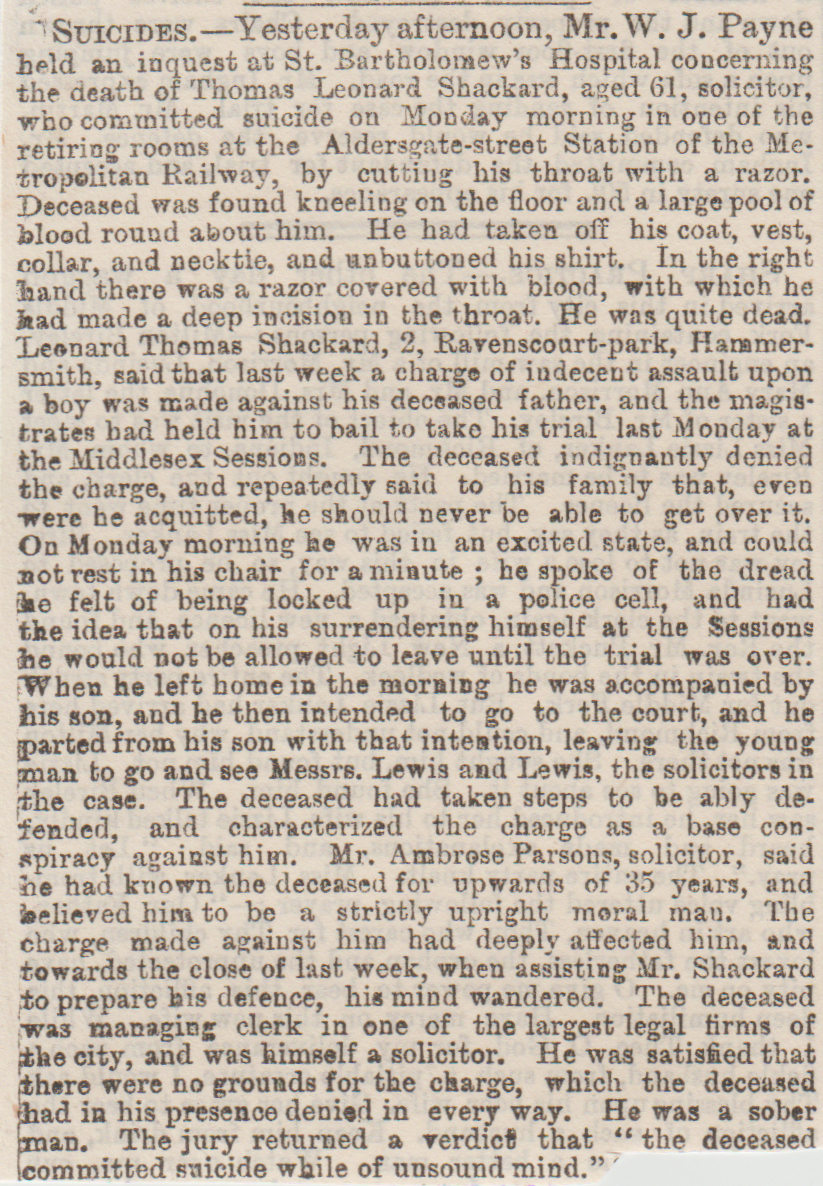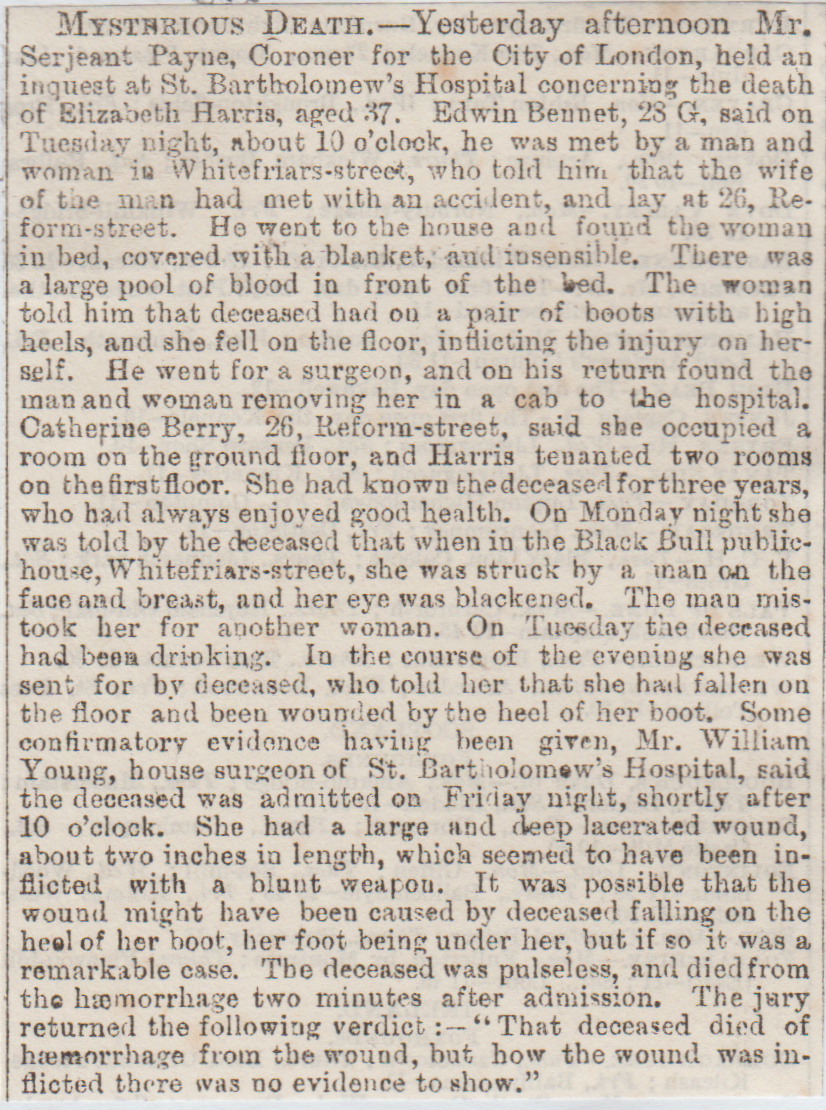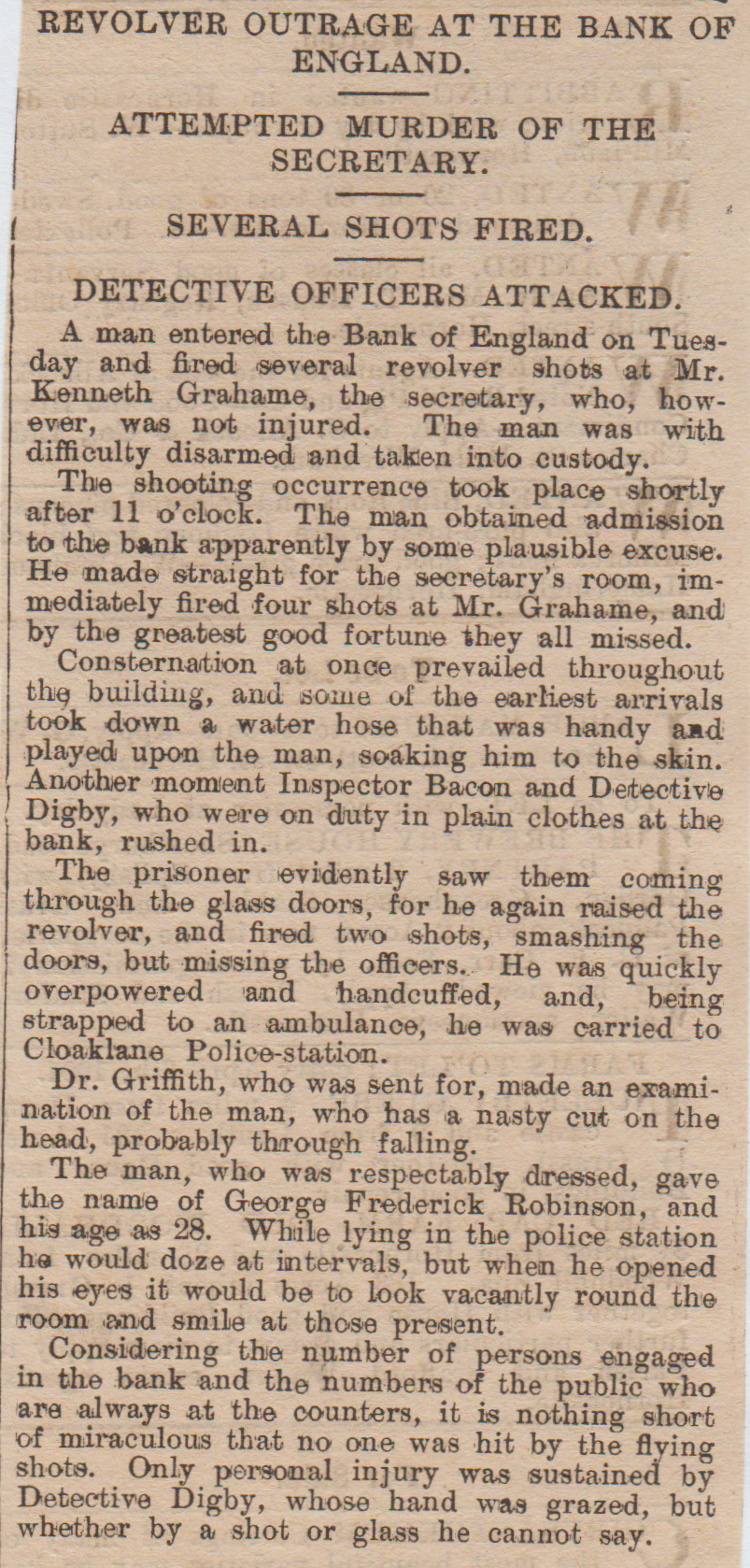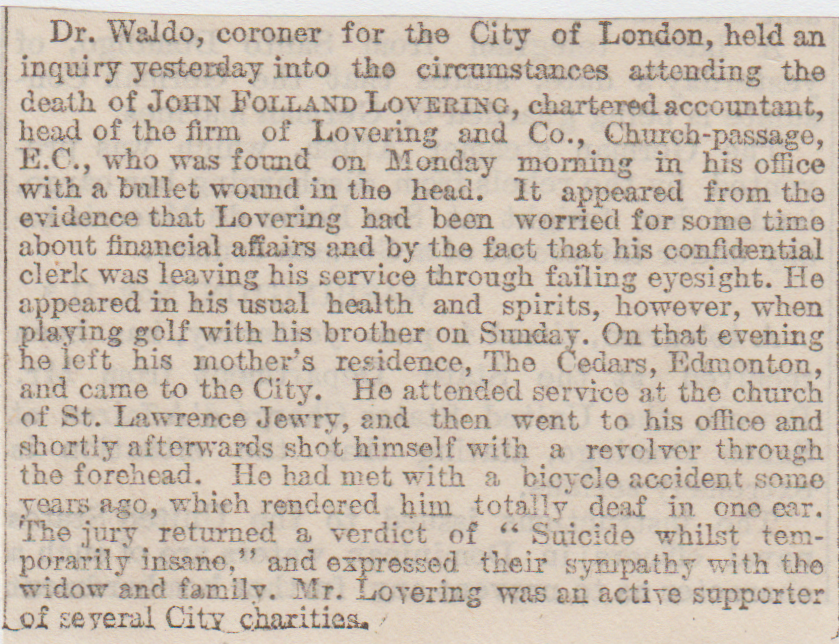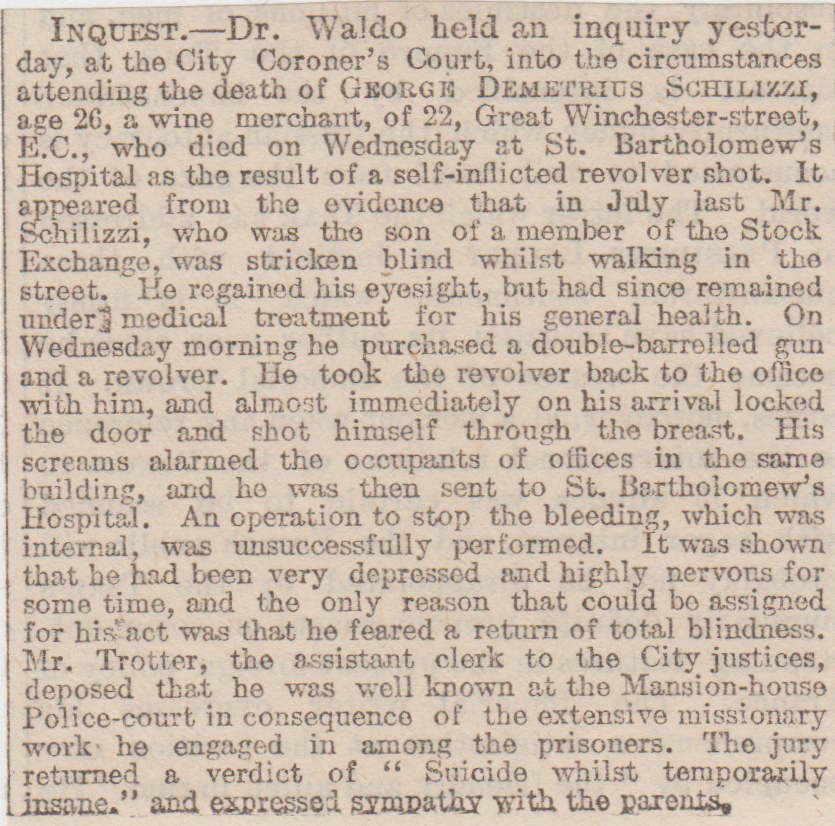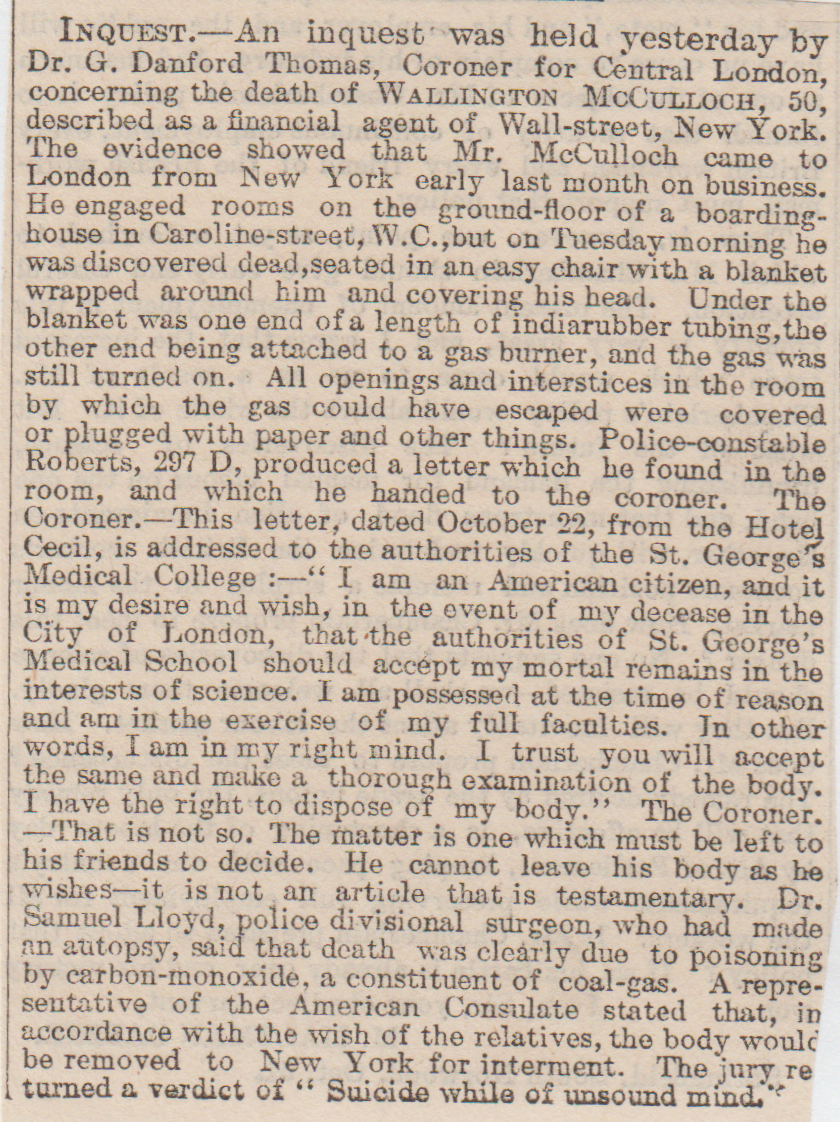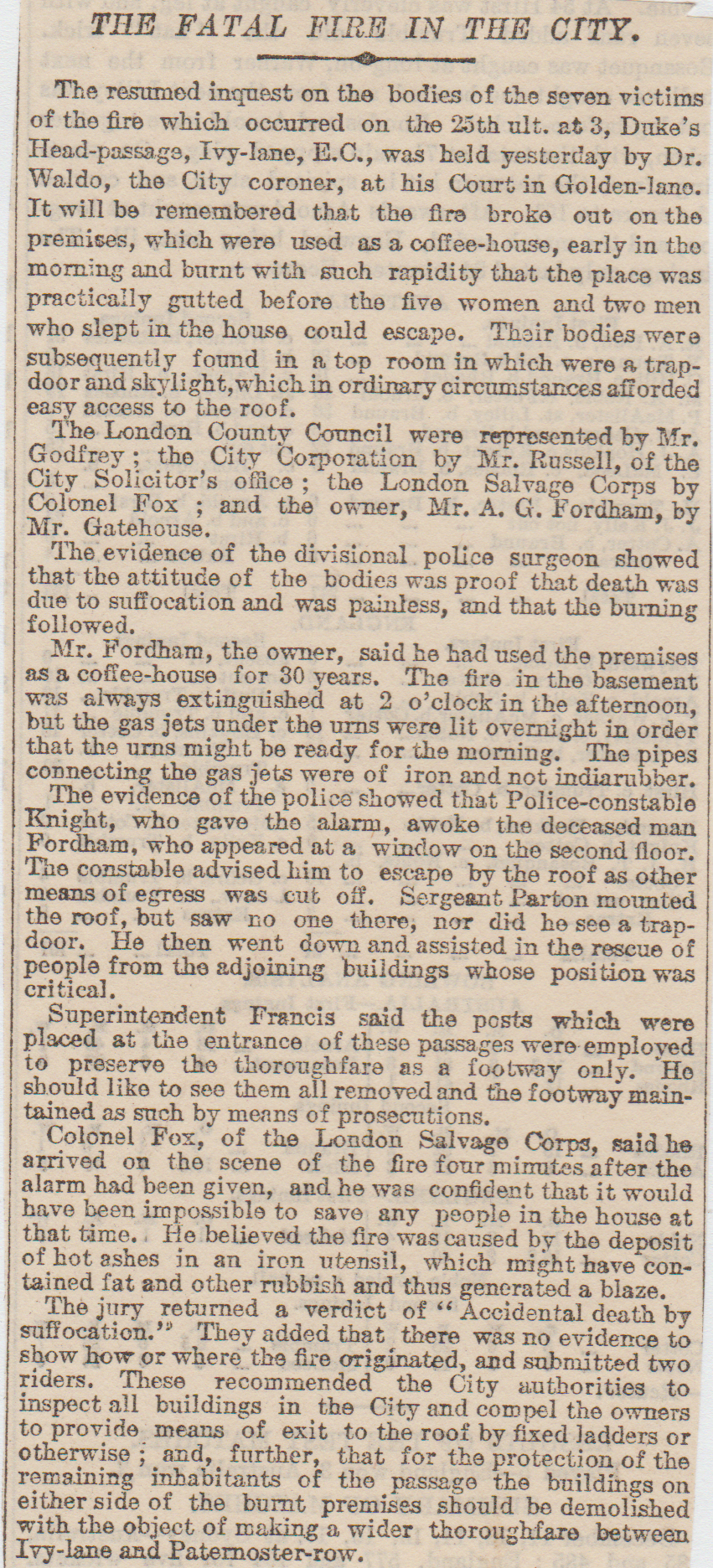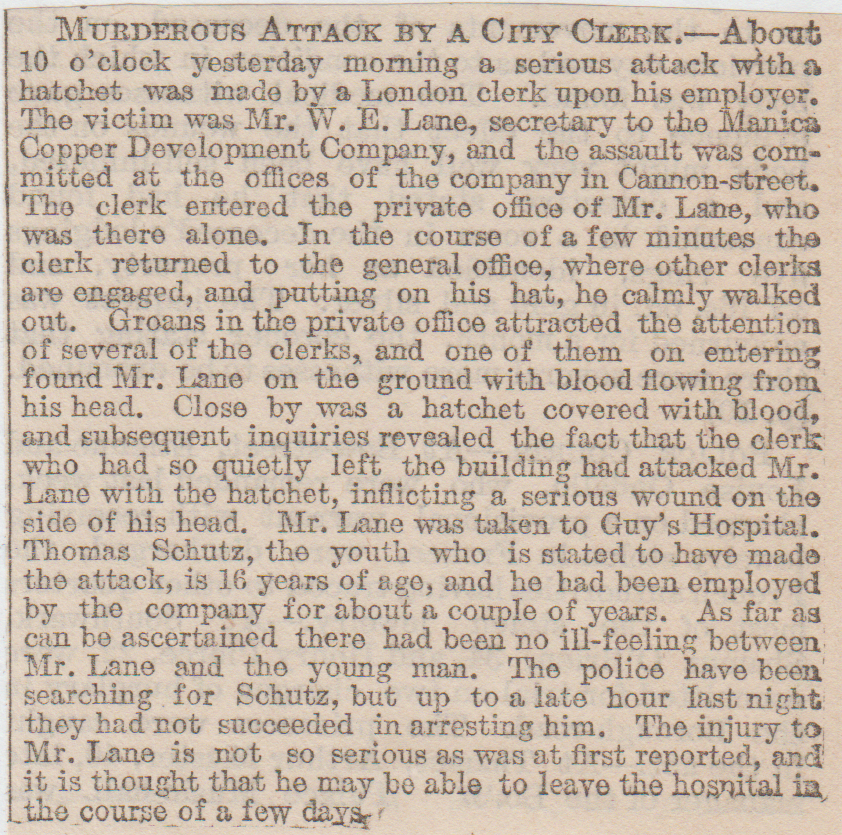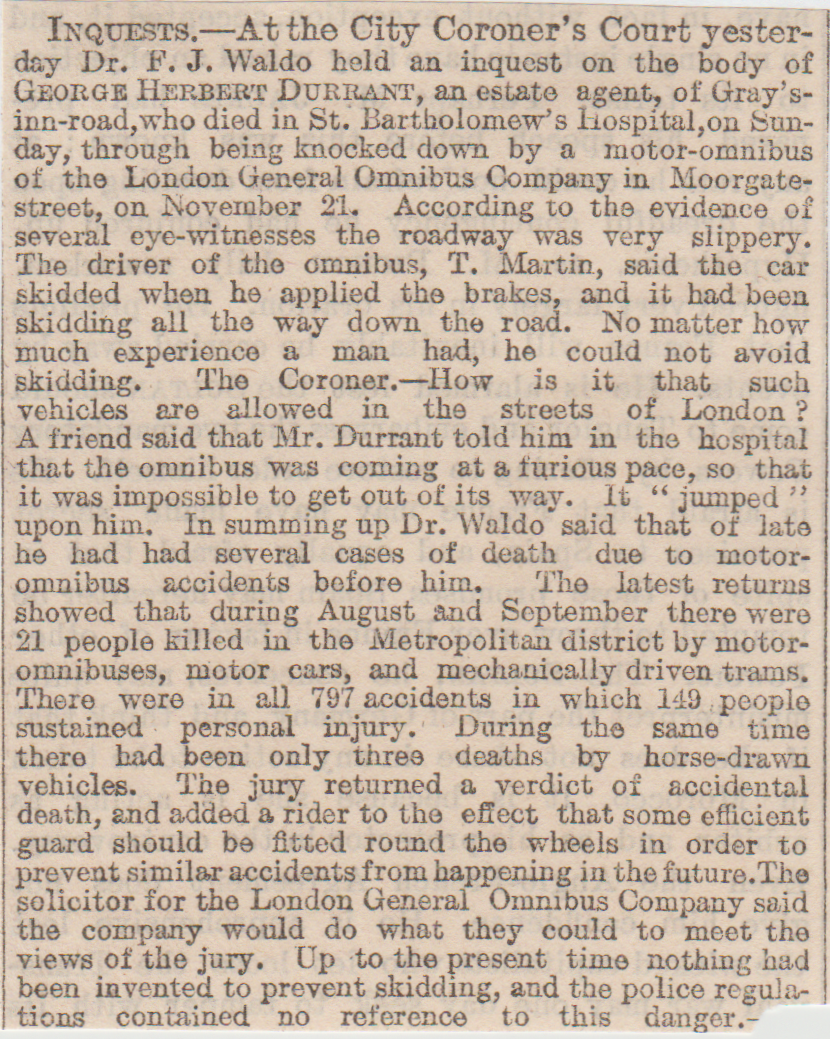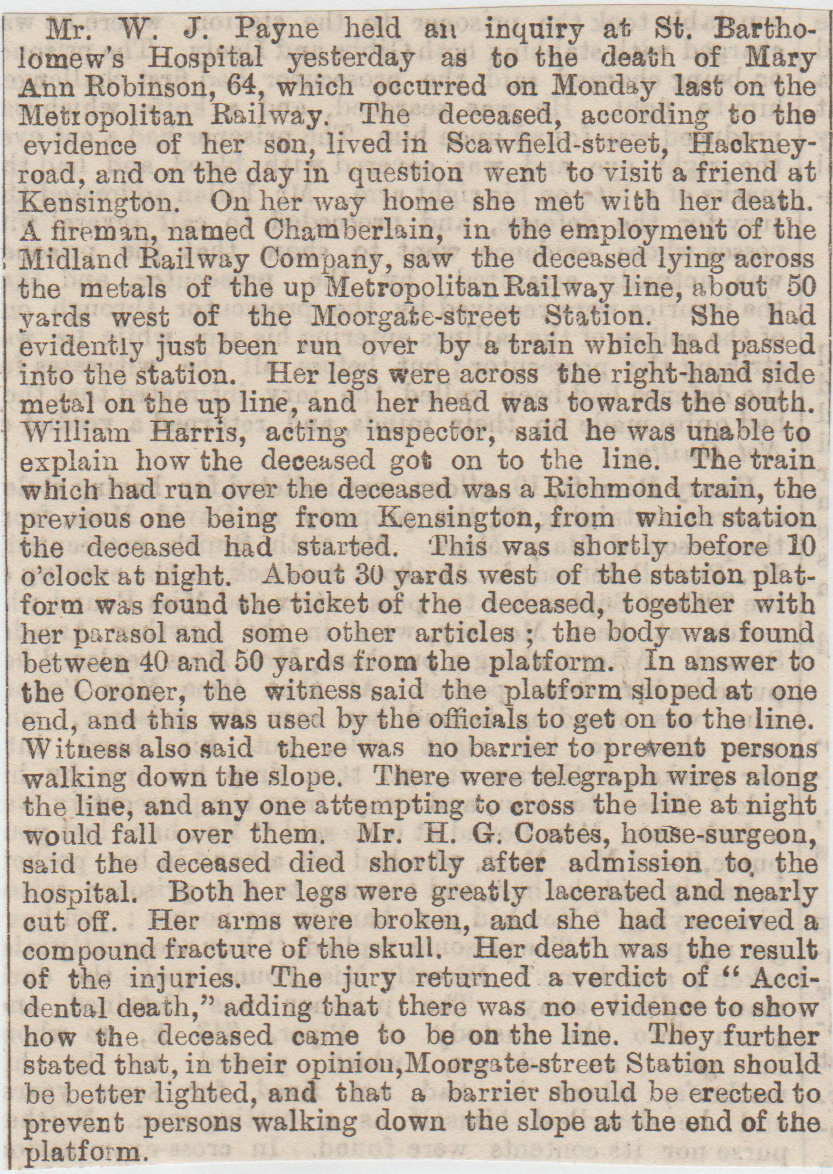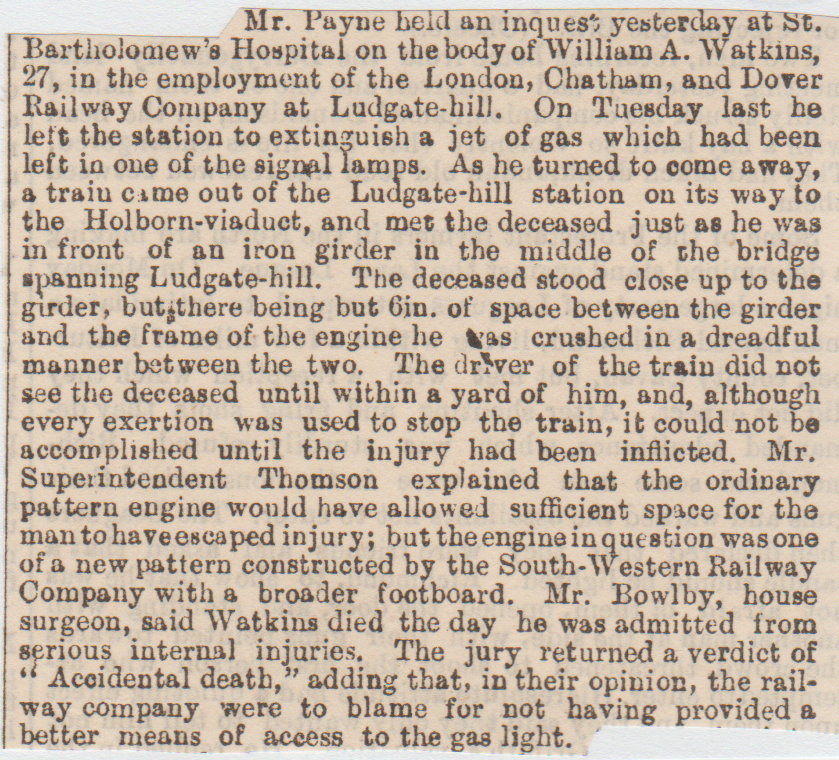1/ Broad Street? City of London, (Body in a Box) April 1899
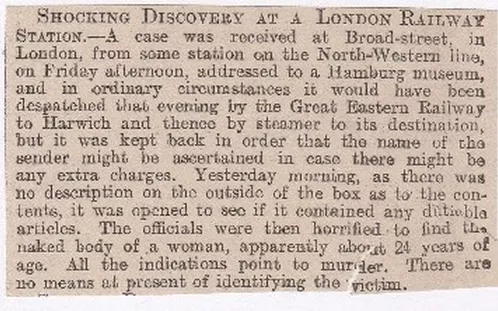
Adjacent to Liverpool Street station. Demolished in 1986, due to lack of passengers. Broadgate office and shopping complex now there, nothing remains of the station.
2/ St Paul’s Cathedral Suicide, October 1890
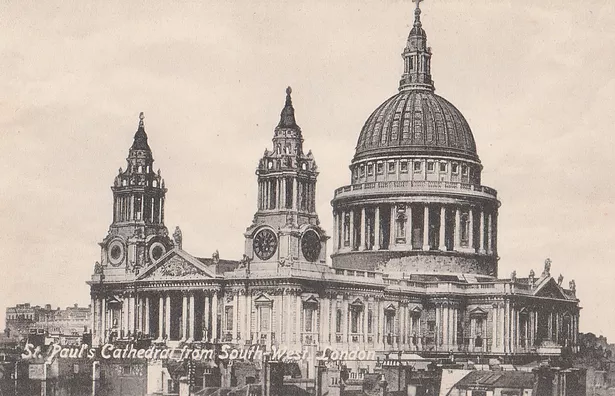
Edward Easton, thirty-eight-years-old, killed himself inside St Paul’s Cathedral by shooting himself one Sunday. He lived with his mother at No 12, Favart Road, Poole Park in Fulham and it was she that went to identify his body. He hadn’t been well recently, the doctor taking care of him told the family that he had suicidal tendencies. He shot himself twice while sat in a chair in the Cathedral, and death was immediate. His mother said he was a religious sort and had changed religion and now was a Secularist. He left his mother the following note explaining the situation:-
“Dear Mother- If I should die suddenly I offer you this memorandum to show that no individual- least of all yourself- is the cause of my death, but false Christianity- Your affectionate son, Edward”
And on a scrap of paper found on the corpse, was written the following:-
“My name is Edward Easton. Christianity has murdered me. The reason I try to commit suicide in a church, is to try and help to break up false Christianity”
3/ Paternoster Row, St Paul’s Cathedral, August 1864 (Body found)
A lamplighter was going about his business early one morning turning off the gas when he came across the body of a man hanging from the railings at the rear of the premises in Paternoster Row, which is occupied by the Religious Tract Society. He cut him down and then got help, but it was too late as the bloke was already dead. Police checked his pockets for any clue as to his identity but nothing was there but a few letters in Danish, which mentioned the war.
4/ Whispering Gallery Suicide, St Paul’s Cathedral, January 1878
A man calmly walked toward the entrance, paid his entry fee of sixpence and then sauntered up to the Whispering Gallery. He then plummeted from there to the stone flags below. He was rushed off to St Bartholemew’s Hospital but he was already dead. The only clue to his identity was the mark “Stephens” in his linen and police are currently making inquiries into the stranger.
5/ St Paul’s Cathedral, February 1896 (Dead Baby Found In St Paul’s)
A newly born baby boy was found dead in St Paul’s Cathedral. The infant was in a package wrapped in brown paper and was discovered when the assistant to the Cathedral, Alfred Larking, was walking down the south aisle when he spotted it on the steps of the reredos. He said that about forty people were milling about the area, where literally anybody could have left the child as the public was constantly in and out. It was wrapped in a blood-soaked towel and the cloth was of the type worn by a barrister or a verger. Cause of death was suffocation, but whether it was deliberate or accidental cannot be determined for definite.

6/ Whispering Gallery Suicide, St Paul’s Cathedral, November 1847
Imagine the scene- Thursday afternoon, 1-30 p.m., the Whispering Gallery in St Paul’s. In walks William Davison a solicitor from Bloomsbury Square. Friends have noticed a change in his behaviour recently but nothing to alarm them as to what was going to happen. Davison left Bloomsbury Square in the morning and then made his way to the Exchange, in order to do a bit of business. Then he goes to St Paul’s, pays the admission fee to see the Whispering Gallery. The attendant in charge of the Gallery, a bloke named Thompson, saw him climb over the railings and plummet down to the stone flags below killing himself instantly. The noise in the Whispering Gallery, echoed around, as he smashed into the floor with a dull thud and Davison had achieved his main aim.
7/ Whispering Gallery Suicide, St Paul’s Cathedral, March 1856
When I was writing and reading these, I thought,”Not another suicide in St Paul’s”. I wonder how many deaths there have been around this giant monolith. I think it’s that thought, that if I’m going to go out, I’ll go out with a bang and make it memorable. Get a few lines in the national papers and be remembered by a bloke on the internet 160 years later or maybe to be nearer to God, on consecrated ground. After all, suicides don’t go to heaven but if I did it in a church, I’d have to. This is Alexander Smart who jumped from the Whispering Gallery, a distance of a hundred feet plus, onto the nave below. He had waited until the clock struck twelve, then laughed hysterically three times and Thompson and Hutchins (vergers) made a dash to grab hold of him, then climbed the handrail and plunged over the edge. He was killed on the spot and the post-mortem revealed his appalling injuries; the head was smashed in, spine dislocated, both legs and one arm broken and the left shoulder fractured.
(In the paper it states that the height of the Gallery is 150 feet. Is it?)
8/ Three Tuns Suicide, Fleet Street, July 1857
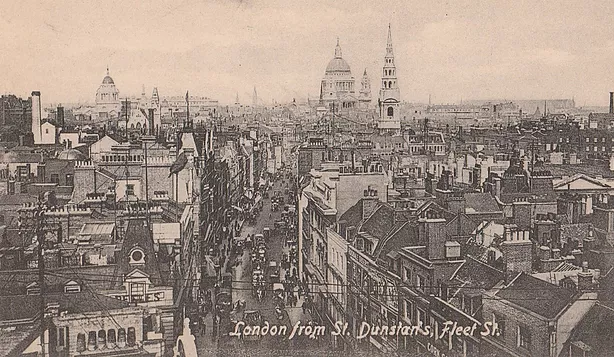
Fleet Street is best known for being the centre of British journalism, but this is about a pub, just off the main street. Somewhere in the mass of houses, pubs, buildings etc.was the public-house of George Jones, who ran the Three Tuns, Great New Street, Fetter Lane, Fleet Street. He was unmarried and employed a potman and two barmaids and when they turned up for work one morning, they were banging on the door and getting no answer they became worried. A search was made and he was found in a water tank, hanging over it. The tank supplied the W.C.’s with water and was on the first floor of the building, so he did remarkably well to reach the thing in the first place.
9/ Thames Embankment, (Thames Suicide) December 1874
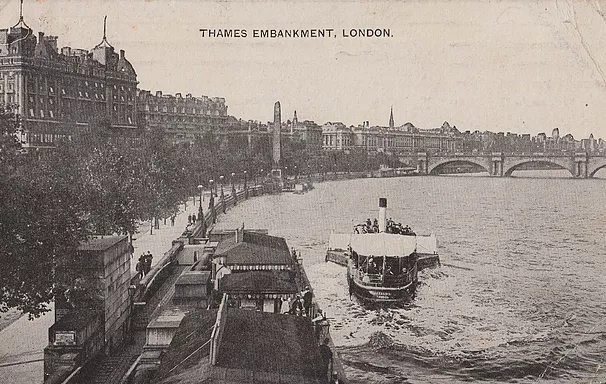
On Christmas Day at Ludgate Hill Station, cabman, Frederick Edwards, got a customer who asked him how much it was to Westminster Bridge. He quoted him one shilling and sixpence, so he agreed and hopped in. They arrived at Temple stairs and he told the cabby “This’ll do. I did not know it was so near”. He then toddled across to the Embankment, said “Goodnight” and jumped into the Thames river. A letter was sent before he did all this and the bizarre jottings read thus:-
“London- Christmas Eve.
My Dear Brother- This will be the last letter you will ever get from me. Had you sent my money when I wrote to you for it, I should not have done what I have done. Please to pay attention to my last remarks and my last requests. I have written a line to all my friends, which you will post as soon as you have them in your possession. My watch is for your eldest. My ring, cigar case, and silk handkerchief to my friend, and my other property. I have paid for everything up to 5-30. I wish my death to be advertised in the Suffolk and Norfolk papers in full. I have stated my wish elsewhere, so I thank you to carry out my request in full, and not to have it reported that you have not done so. I am in my full senses, so, therefore, the coroner and jury need not return a verdict of insanity, for I am not going to starve and beg to oblige and please you and yours. You have my money, and now you can do what you like, as I prefer death to starvation any time- Cornelius Osborne. Born 1848. Died December 24th, 1874 Aged 26 years 5 months and 24 days.
His brother, Jabez Osborne, said that Cornelius had inherited some money when the father died, but he spent it all, and Jabez kept giving him a cheque every now and then to help him out. A letter came to Jabez, asking him for more money, but he threw it in the fire. He lodged at Mr Poulton’s in 119, High Holborn, and told him about his plan to kill himself, but he thought he was kidding. He wasn’t!
Monument Suicides, London
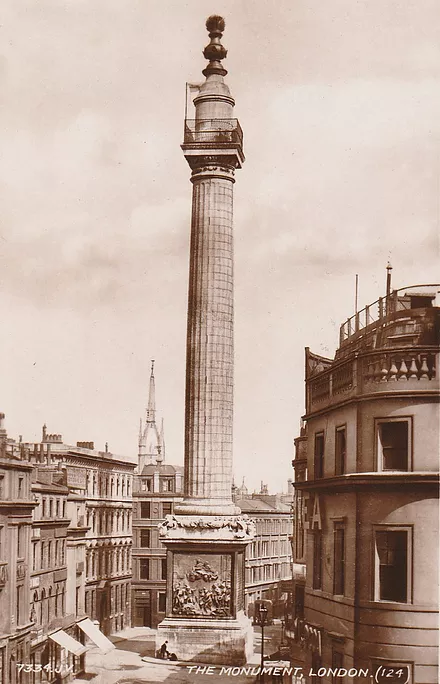
IT IS 202 FEET HIGH, WITH 311 STEPS TO THE TOP, AND SIX PEOPLE JUMPED OFF THIS, BETWEEN 1788-1842. A TYPE OF WIRE MESH WAS PUT ROUND THE TOP PLATFORM TO STOP THE GLUT OF SUICIDES.
10/ September 1839
It had been nearly three decades since the last suicide at the Monument but on Wednesday 11th September, at a quarter past ten in the morning, Margaret Moyes dived off the top of it. The bloke who took the entry fees, Thomas Jenkins, took her sixpence. Moyes then asked if a gentleman and two ladies had been there and he replied “No”. She seemed surprised and asked if she could sit inside the railings at the base of the Monument and he agreed. She sat there with Jenkins for about twenty minutes then said she’d go up on her own as she was sick of waiting for her friends to turn up. She went up, then shortly after jumped off the platform. She was about twenty-five-years-old, fair complexion, well-dressed, and about five feet two inches tall. A post-mortem examination gave these as the following injuries- Fractured spinal column, blood emanating from the mouth, eyes and nostrils, left arm severed above the elbow (kept in place by sleeve). She bent a railing on impact below and just avoided the ornamental griffins on the base. A note was found in a pocket-book saying- You need not expect me to return home, for I have gone out with the determination to destroy myself”. The day after this Fish Hill was absolutely jam-packed with people wanting to see the place where Moyes landed.
11/ October 1839
This next one is seen as a copycat suicide and it being so close to Moyes’s self-destruction, it is too coincidental. A rather impressionable fifteen-year-old boy named Robert Donaldson Hawes, who worked as a porter in Gracechurch Street was seen by Jenkins, to clamber over the iron railings of the gallery at the top (as you can see). His frail little body was forty feet from the base and with blood and brain matter spread all over. He must have landed on his back, due to lack of markings to the face and he clutched a Bible in his hands.
12/ August 1842 (Final Suicide From The Monument)
Ever since the suicides in 1839, a guard had been put on the top to prevent such actions recurring again. Jenkins was still taking the money at the base and Nathaniel Fletcher was patrolling in the morning. A lass in her teens paid her money and went to the top. She walked around a couple of times taking in the magnificent views when Fletcher suddenly lost sight of her. He ran down the stairs to see if she’d come down but she had by now thrown herself off the column. Jenkins said he heard a loud crash similar to a carriage being upset but they found the young lady bleeding profusely from the ears and head. A witness said she used the flagstaff (you can see it in the picture) to lever herself over the railings. Her body smashed into the stone dragon on impact, North West corner about fifty feet from the base. She was identified as Jane Cooper, a seventeen-year-old domestic servant and this makes the sixth person to kill themselves here.
John Craddock, baker- 7th July, 1788: Lyon Levi, Jewish diamond merchant- 18th January, 1810: Leander, baker- 1810: Margaret Moyes, bakers daughter- 11th September, 1839: Robert Hawes, a 15-year-old boy- 18th October, 1839: Jane Cooper, 17 year old domestic servant- 19th August, 1842
Ludgate Hill, London
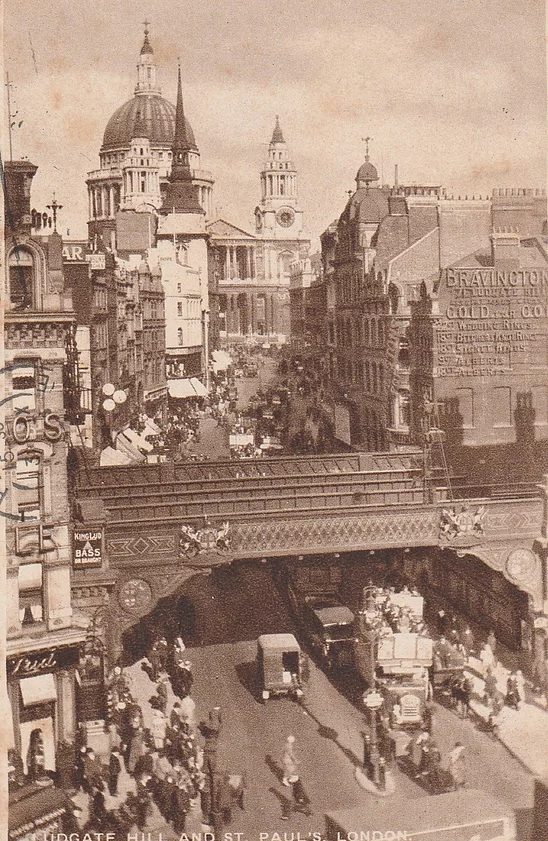
13/ Ludgate Hill Station Suicide, July 1867 (Above picture is the closest I had)
Henry Bowles aged thirty-eight was discovered in a closet at Ludgate Hill Station, supposedly he had committed suicide by poisoning himself with prussic acid. Why? Well, he was an accountant earning around £1 a week, plus board and lodging. He had been working for a Mr Bickley for the past year when his accounting books were checked, it was found that £40 was missing. When he was asked about the deficiency he admitted to it straight away but said it was only £20 that he side-lined for himself. Not long after this, probably knowing the consequences that were coming he was found at Ludgate Hill Station.
(Ludgate Hill Station was opened in 1865 and was closed in 1929)
14/ Ludgate Hill Station Suicide, January 1878
Another suicide in a closet at Ludgate Hill Station! The young lad’s name is Joseph Kirkley Galloway, only eighteen-years-old and it seems that he came from a good background, with no money worries and always seemed to be fairly chipper. He was whisked off to St Bartholomew’s Hospital and the bullet wound was examined. It was above the ear and it is thought that he may not pull through. His mother visited him and was at a loss as to why he would attempt suicide. (Did he die?)
15/ Ludgate Hill Station Suicide, April 1869
At two p.m. one Friday, a young chap walks into one of the W.C.’s at Ludgate Hill Station. Later on, the place was checked over as nobody had seen him, and lo and behold there he was lying on the floor, with blood oozing from a self-inflicted gunshot wound.
On his person was found the receipt for the gun, at Messrs Reilly of Oxford Street, for £2 and 15 shillings, a hanky with the initials “W.B.” on it, a hotel bill from Stanley’s Hotel, Leamington Spa, and another from the Red Horse in Stratford-on-Avon. Other bits and bobs revealed a Crystal Palace season ticket with W.C.Bumstead, Stonely Villa, Clapham, on it and a couple of tenners, a huge amount in those days. His brother identified the corpse and said that he had been going around the country visiting places for his health. Two men tried to pass themselves off as relatives in order to claim the money found on him. When told to go to the police station, they legged it. Suicide due to ill-health probably.
16/ Newgate Prison Execution, December 1885 (Murdered at 3, Ammiel Terrace, High Street, Bromley-by-Bow
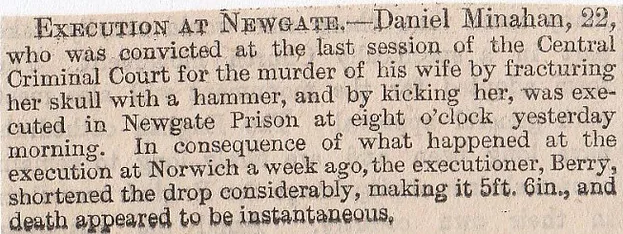
The mistake made by James Berry at Norwich Gaol on the 30th of November 1885, was when he attempted to hang Robert Goodale, but instead of hanging him, when he dropped through the trap-door his head was torn off his body. See also Norfolk section (No.45 )
17/ White Lion Street, Pentonville, July 1837 (Pierced on Railings)
At about eight a.m. at the front of a house in White Lion Street in Pentonville, a decorator named William Fry fell from a ladder while painting on the second storey. Nine times out of ten you’d survive a fall of twenty feet or so, but Fry landed directly on the spiked railings outside the residence. Four of them pierced his body and he was dangling there until witnesses to the horrific accident took him off them. He was taken to the hospital, but his chances of making it are virtually zero.
18/ Christ’s Hospital, May 1857 (Impaled on Spikes)
Three p.m. Saturday and the Blue Coat Boys of Christ’s Hospital, Newgate Street were playing sports, when a couple of them tried to scale a wall in the playground which is next to Giltspur Street. The first one went over and performed it perfectly, then the next lad only sixteen tried it and must have forgotten about the spiked railings on Mr Gilruth the baker’s property and he was impaled on them. In shock more than anything, they ran around like headless chickens for a few minutes and then went to get help. He was removed and surgeons from St Bartholemew’s tried to save the lad.
19/ Fenchurch Street Suicide, June 1862
George Hay, a clerk at a merchant’s in Mark Lane, killed himself in a singular manner in Fenchurch Street, London. He kneeled down on the kerb and carefully placed his head under the oncoming wheels of a fully laden charcoal waggon. His head was squashed to pieces and death was instantaneous.
20/ Newgate Prison Suicide, January 1852
An inquest was held on the suicide of Flannigan, who drowned himself at Newgate by putting his head in a bucket of water. This was due to him not receiving any friends or family as visitors, as they had all washed their hands of him and with this, his spirits had become lower and lower. Flannigan also liked a tipple and he hadn’t had a drink for a while, and delirium tremens had taken effect. The verdict was “Temporary Insanity”.
21/ Newgate Prison Execution, March 1899

22/ City Theatre Fatality, London April 1833
The inquest into the unfortunate death of 15-year-old Emma Teulon who was struck by a bottle about three weeks ago at the City Theatre. (I think it was on Milton Street, near Barbican Centre) She sustained a fractured skull and was rushed to St Bartholemew’s Hospital, but she died from erysipelas (bacterial infection, causes red patches on the skin). It was not certain whether it was deliberate or an accident and the lad who had the bottle was due to appear.
23/ Warwick Lane Restaurant Suicide, (Near St Paul’s Cathedral) November 1876
Richard Bath, a thirty-year-old gasfitter living at Millfield Place, Green Lanes, Stoke Newington, walked into a restaurant with his missus and ordered some lunch. Bath suddenly grabbed a knife from the table and slit his throat in front of his wife and other customers. So deep was the wound to his neck, that it was barely held on by a flap of skin. This was kind of a making-up dinner, as he had just come out of prison for three months for assaulting her, but death came within a few minutes.
24/ Cannon Street Station Fatality, August 1905
A lad named Beazley (Great name!), who worked at the Commercial Telegraph Bureau in Mincing Lane and took the letters to post at Cannon Street Station, was killed while he was posting the letters, he mounted a tender and when he realised it was being shunted, he leapt onto the line. He stumbled and fell under the wheels of a passing carriage. He was discovered lying on the rails, his head being terribly crushed.
25/ East India Avenue Assault, August 1899
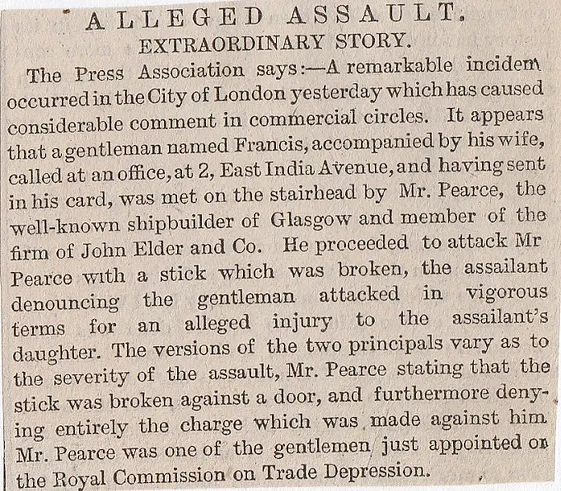
26/ King William Street, February 1852
This street is near the Monument to the Great Fire of London and was the scene of a bizarre suicide attempt. A City policeman was patrolling the area around King William Street when he saw flames emanating from a man’s mouth, who was standing on the corner. The Frenchman had tried to commit suicide by putting an egg yolk with three ounces of gunpowder in his gob, then lighting a fuse and tried to blow his head off. He escaped major injury but received severe burns to his mouth and throat.
27/ Poultry, (Fire-Engine Fatality) September 1850
This is a road near the Bank of England. One morning a fire engine was rattling along Poultry and going towards Cornhill. When it was near the Mansion House the pole of the engine smacked a smartly-dressed young man by the name of Alexander Dupree Dunning, and if that wasn’t bad enough a wheel passed over his neck, then another over his head. Then the horses were stopped and a fireman went to see if the young man was badly hurt. There was blood everywhere and he was taken immediately to Guy’s Hospital. Unfortunately, the injuries were too bad and he died. A verdict of “Accidental death.”
28/ Newgate Suicide, June 1833
Edward Foley aged thirteen was a career criminal even at this young age. Nowadays he’d be put in a Young Offenders Institution. He had just been sentenced to seven years transportation to Australia (poor bugger!) for the crime of highway robbery. Sort of a mini Dick Turpin. He was put in the care of Mr Lloyd, schoolmaster, and had become a stubborn little fella. Lloyd found out that he was head of a conspiracy among the other lads who intended to grab him and give him a good kicking. Foley was put in solitary, but when they went to get him out he was found hanging by his neckerchief to a candlestick to a wall. He was in a kneeling position, as the fixture was only three feet from the floor. “Felo de Se” was the verdict.
29/ Newgate Prison Execution, January 1899

30/ St Paul’s Station, Blackfriars, (Bodies in Box) January 1907
The decaying bodies of two children were discovered inside a trunk at St Paul’s Station in Blackfriars. This is not an unusual crime in Victorian Britain. The metal box had been at the Lost Property Office for about eighteen months and there was a horrible stench coming from it, so finally they opened it up. There were a few letters in the box as well, but police are making inquiries.
31/ St Bartholemews Hospital Suicide, August 1844
Nineteen-year-old Thomas Reidy committed suicide by hanging himself. He had been showing signs recently that he was losing it. Friends thought it was due to his studying too hard for his engineer’s position, but he was also ultra-religious, saying that “God ordained him to die, and die he should”. The nurse, Ann Harris, said he often talked of suicide and told her “murder and suicide were always uppermost in my mind”. Talk like this got him put in St Bart’s in the first place and when he was found hanging to a window-bar, it was no surprise to anyone.
32/ Newgate Execution, April 1892
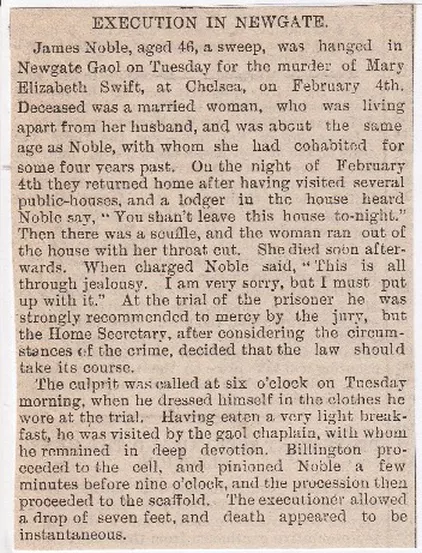
33/ Mansion House Station, (Child in Package)August 1888
The train from Broad Street via Willesden Junction trundled into Mansion House Station at 9-34 p.m. Police had been told that staff had discovered a body of a baby boy in the third-class carriage, wrapped in paper and old rags. A passenger found it when he was searching around the carriage looking for the source of an awful smell. He looked under the seats and there was the decomposed child. (Was it ever identified?)
34/ Aldgate Station, (Child in Package) December 1877
Another body of a murdered child found on London’s railways. This one was found by a porter at Aldgate Station on a Sunday night when he entered a third-class carriage and found a package left on the seat. It was opened up and a newly-born female wrapped up in some brown paper and an old towel. Post-mortem examinations revealed that the child had been physically abused. Police have questioned passengers at various stations along the line as to whether they had seen anyone with such a parcel, but have discovered nobody that fits the bill.
35/ Houndsditch Murder, September 1899
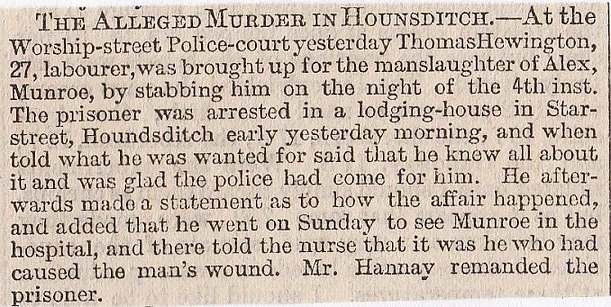
36/ Blackfriars Station, (Human Body Parts) July 1886
Portions of a human body were discovered on the District Railway when an employee at Blackfriars Station found an arm, a leg and a foot on the tracks. Police were called and are investigating the situation. They were carefully wrapped in a towel and the main theory is that they were thrown from a passing train.
37/ Cannon Street Station Suicide, December 1887
A gentleman committed suicide at Cannon Street Station by shooting himself. Mr Gideon Turnbull aged thirty-four of Santa Croix, Surbiton Hill, who was a wine-merchant by trade, had been low in spirits for the past week a half. He had invested some money in some business which turned out to be a complete waste of time. Now financially he was ruined and all his cash had been effectively flushed down the bog, so there was no other answer, but to kill himself.
38/ Cannon Street Station Suicide, April 1868
Very similar to the other Cannon Street suicide. This was a smartly-dressed man in his forties blew his brains out with a handgun. He went into a W.C. and locked the door. An employee noticed that he hadn’t come out for a while and tried to open the closet door. He got other staff to help him break it open and he found deceased, with the top of his head shot off by the old pistol. He had placed the muzzle in his mouth and pointed it upwards, causing the injury mentioned. He was identified as William Clark who worked in the Custom House offices.
39/ St Bartholemew’s Hospital, (Kicked to Death) August 1892
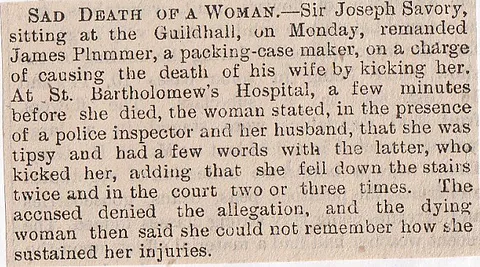
40/ Smithfield Suicide, July 1862 (Lovesick Pensioner)
William Bailey aged sixty-three was an inmate of the West London Union and had been for the last eighteen months. He used to be well off and was a member of a respectable family, but Lady Luck hadn’t sprinkled her glitter on this old fella for quite a while. One good thing to come his way were the attentions of a much younger woman. She was an Infirmary nurse whose husband was a soldier, away on active duty on foreign soil and they could only meet fleetingly in the storeroom for a quick kiss and cuddle. They had a petty argument one day and it’s thought that this led to him hanging himself from a beam, by a couple of leather straps. He’d had a tipple beforehand which made him a bit moody and sullen. When the young nurse was questioned about the argument she said that it was because a friend of his had passed away and they hadn’t bickered in any way. (I wonder why he did kill himself?)
41/ Apothecaries Hall Explosion, June 1842 (Blackfriars Lane, near St Paul’s Cathedral)
An appalling accident caused the demise of a well-liked servant of the Apothecaries Company. Mr Hennell, who was the chemical operator of the company was fulminating mercury for percussion caps which were to be used in the East Indies. Three reports were heard then a much louder one, which caused the foundations to shake. Mr Hennell’s body or what was left of it, had his right arm torn off by the explosion and the right side of his face was missing, minus the top of his head. The rib-cage was blown open revealing his internal organs and heart. Pieces of him picked up by workmen from the roofs of adjoining houses.
42/ Newgate Prison Execution, July 1885

43/ Liverpool Street Station, (Child Remains) July 1896
Another story of how somebody had put a dead child in a box and left it on a train. I bet you that 90% of train stations had a story similar to this one. Liverpool Street Station lost property had a package deposited there which was a nicely wrapped parcel, found in 2nd Class on the Norwich express. The usual thing, that a funny smell was coming from it, so police were informed. When opened, it contained the body of a child who had been suffocated with a piece of wadding in its throat, then had its skull smashed in with some sort of blunt instrument. It was classed as a case of child murder and City police did everything they could to find the perpetrator of the crime, but apart from the Norwich connection, they had very little to go on.
44/ Liverpool Street Station Suicide, September 1888
This time it was an act of suicide at the famous train station. At four p.m. one afternoon, a nicely dressed woman about thirty odd, was sat in the waiting-room at Liverpool Street Station when she got up and told the bloke next to her that she poisoned herself. She then screamed and dropped down on the floor. A railway company’s doctor tried to revive her but she died soon after. Police took the body to the mortuary at Golden Lane and found some cash, plus the following letter with no address on it:
“Dear Tom- I could not see the things taken from my house. What I said this morning is true. Pray to God for me, your distressed wife. I hope God will forgive me and help you. I cannot stand it any longer; it is too much for me. Goodbye. Farewell-Lucy”
An address “Mrs Groves, Halley Road, Enfield Lock” was found on a bit of paper, but not the same writing as on the letter. The Jane Doe has not yet been identified.
45/ Henry the Eighth’s Chapel Suicide, August 1838
Around the area of St Bartholemew’s Hospital, there was quite a buzz when a suicide was found in the chapel of Henry the Eighth. It was the sexton, Mr Thomas Thurrel, who had been missing for several days previous to his being found. He had the keys to the chapel which adjoins St Bart’s, and someone wanted to go into the chapel but no answer came from his house. The chapel doors were pried open and Thurrel was found hanging from a beam in the belfry. He was starting to decay, so it was deduced that he’d been there a couple of days, but as to a reason why he did this is still unknown. (Can I visit Chapel?)
46/ Fleet Street Suicide, July 1889
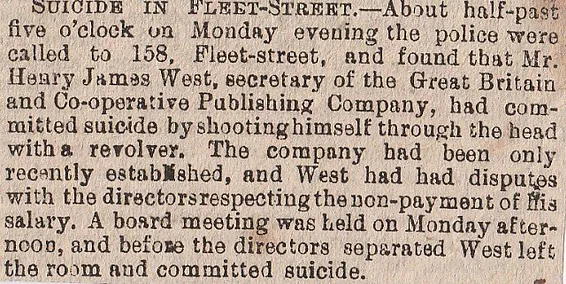
47/ Barbican Suicide, August 1871
A fifty-year-old police sergeant, Robert Bridle, killed himself in a singular manner in his garden shed near Barbican. He had a wife and three kids and was put on the pension list a few years ago. Problem was that he was drinking very heavily and the arguments with his wife were more and more frequent. At tea-time, one day he went to his garden shed for a bit of me-time and ten minutes later there was a tremendous explosion, with pieces of wood from his shed lying all around the garden. Bridle was laid on his back and badly burned, but he was shovelled into a cab and taken to the hospital. While in the cab he put his hand in his pocket and pulled out a razor and then slit his throat from ear to ear. Two young men who were accompanying him to hospital wrestled the razor from him, but amazingly he brought out another one and finished the job.
48/ “Times” Office, Blackfriars, July 1868 (Human Remains)
While some alterations were being made at the Times office in Blackfriars, there was a lot of digging going on and it was then, that a workman found a human skull. More digging revealed two more skulls plus the bones from three bodies. They had been buried for some considerable time but were in remarkable condition. One is of a young man, teeth still intact, with the others being slightly broken. It was believed to be the site of a monastery in Blackfriars and the skeletons are possibly those of inmates from centuries ago when it was then a quiet resting place.
49/ Harcourt Buildings, Inner Temple, January 1885
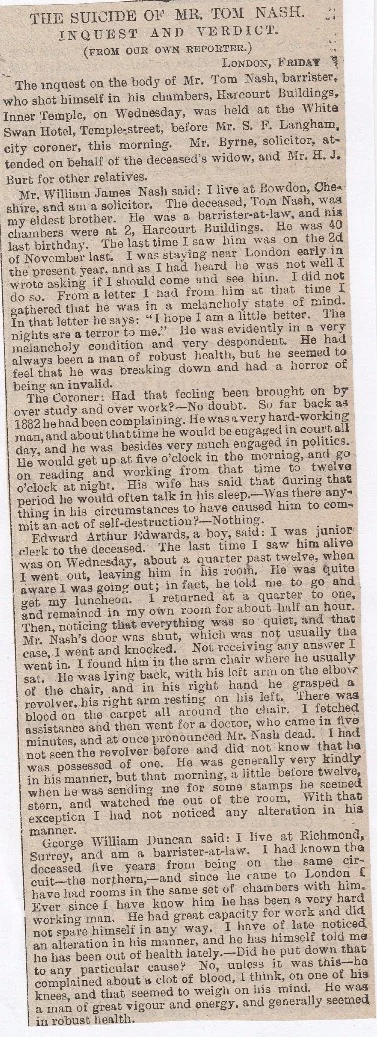
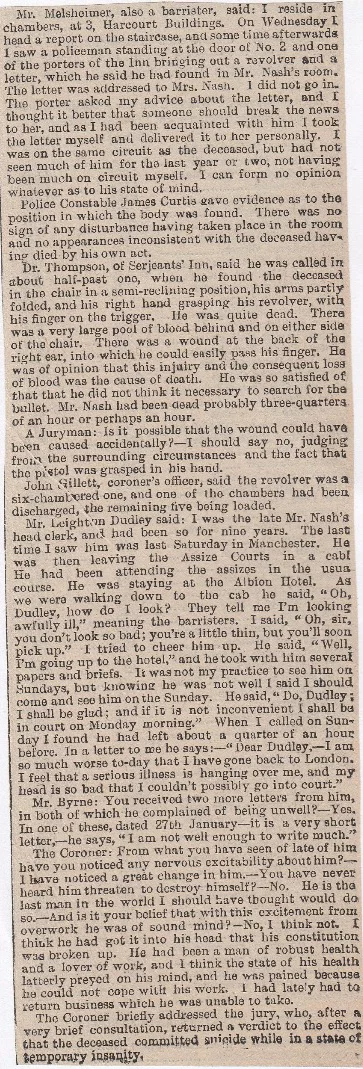
50/ Bishopsgate Street Station Suicide, September 1881
This suicide left a critical clue on his ticket. A train pulls into Bishopsgate Street Station at 1-12 p.m.when a gentleman went up to the booking office and got a third-class ticket to Bethnal Green Junction, then he quickly scribbled some words on it. He then climbed the stairs just as the train was coming into the station, then he jumped onto the ballast and fell over the rails. The driver tried to slam on the brakes but he ran over him, decapitating the man and leaving his head several metres from the trunk of his body. The ticket in his pocket was checked over and all it said was “Deceived you yet”. The man’s name is unknown, but he was about thirty-five-years-old, dark complexion, long dark hair and clean shaven. Black coat, tweed trousers, black hat and boots and personal possessions were a key, two files, corkscrew, some change and another smaller key. Go figure!
51/ St Mary Axe Suicide, October 1858
St Mary Axe may ring a bell with some of you because that is the address of the Gherkin. Miss Leigh Bunyon aged forty-two was discovered in a vapour bath in St Mary Axe, under some strange circumstances. She entered the baths and stayed in there for an hour and a half, which is not an unusual length of time to spend in there. An attendant heard the sound of running water and it was continuous so they went to see if she was OK. Miss Bunyon was floating in the bath, dead as a door-nail. A doctor surmised that she had poisoned herself and lo and behold, they found a bottle of sulphuric acid in the bathroom. Judging by the footprints and other clues, she had had a bath first, then got out, hence the wet footmarks on the steps, swallowed the acid, then racked with violent pains and spasms as the acid ate her insides away, she got back in the bath and turned the tap on.
52/ Woolpack Hotel Murder/Suicide, Wood Street, December 1900
A publican’s wife flirting a bit too much with the customers was the final straw for the husband and it ended up costing her, her life. Police went to the Woolpack Hotel in Wood Street and found two bodies on the premises. One was the good-looking wife Mrs North and the other was her husband, Mr William James North. He was stone-cold sober all the time, unusual for a Victorian publican, but she made up for the two of them as she was rat-arsed most of the time. Being so attractive she liked to flirt with the male customers, but the husband had had years of this and finally, he flipped. They were found in the cellar, both had been shot and all the chambers were empty, the majority of bullets were in her body. They had a couple of kids aged three and five, but friends were looking after them while the two sorted out their private life. They were going to get a divorce and they tried to give it another go, but this was the end result. (Between St Paul’s and the Barbican)
53/ Union Street, Aldgate, July 1895 (Highway Robbery)
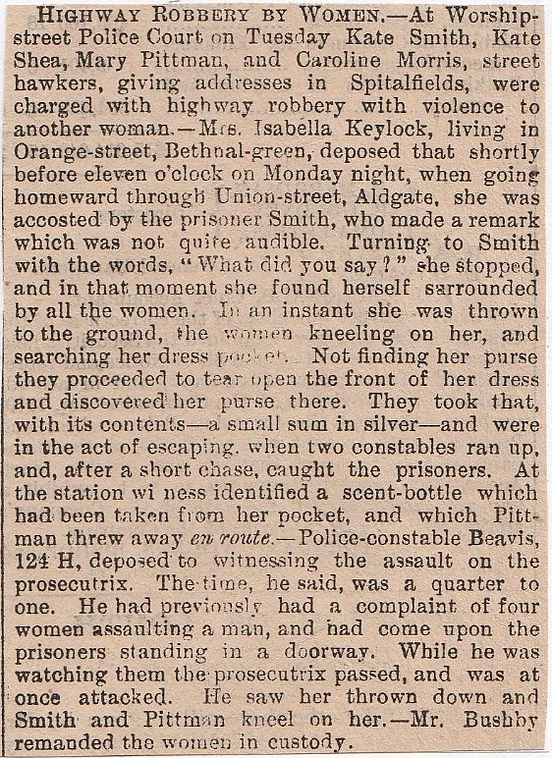
54/ St Bartholemew’s Hospital Suicide, July 1868
Thirty-year-old John Bryant was an entertainer in the music-halls and he was a heavy drinker. He also got sunstroke while he was in India, which really doesn’t help the situation. But what he did next really is not the action of a sane man. He was admitted on Thursday morning and put into bed near a window. The nurse went to get his medicine when there was an almighty crash and on returning to the ward, found that Mr Bryant had sprung through the window, a fallen a distance of thirty-five feet. He suffered terrible injuries and did not live long. It was thought to be delirium tremens and the effects thereof, but the doctor explained that he was only there to rest and recuperate.
55/ St Michaels Church Murder/Suicide, Aldermanbury, (Near St Paul’s)
Yet another church suicide accompanied by a murder, but this one cannot be visited as it was demolished in 1900. The perpetrator of this crime was the grave-digger named Holden. St Michael’s had been undergoing repairs and Holden and his missus, the sextoness, had entered the church at 6-30 a.m. to give it a good clean. At 7-15 the daughter went to tell them breakfast was ready and found her mother lying on the floor with her throat slashed and her father on top of her, with his throat cut and blood oozing from the pair of them. They argued at regular intervals, mainly about how much he was drinking and there was an age gap between them, he was seventy and she was fifty-odd.
56/ Farringdon Street, Druid’s Hall Suicide, September 1849
James Powell, a waiter at the Druid’s Hall in Farringdon Street, killed himself in an extraordinary fashion at his place of work. He was so down in the dumps and morose that Mrs Powell asked Mr Taylor, a hatter, who owned the shop under Druid’s Hall, to go and have a word with him. Taylor walked into the room and saw Powell staring out of the window. He asked him what was wrong, then he turned around and looked him full in the face. Taylor put his hand on his shoulder, then Powell whipped out a pistol and shot himself in the chest. Inquiries by police find that he pawned a coat then bought the pistol; also that, rather comically, he had lost the sight in one of his eyes when the cork of a ginger beer bottle impacted his eyeball while opening it.
57/ Little Swan Alley, near London Wall, September 1856 (Five dead as Houses Collapse)
Three houses in a poor state of repair in Little Swan Alley, off Bell Alley in Coleman Street, simply collapsed in the middle of the night, while everyone was asleep in bed causing five people to lose to lose their lives. P.C.Hewitt was patrolling the area when he heard an enormous crash, then dust and debris were strewn about. People were clambering out with cuts and bruises and broken limbs, but five never made it. A man named Palmer, his three children and a child of a lodger were killed. The building was three stories high, but now was a pile of rubble.
58/ Cannon Street Murder, June 1866

59/ Messrs Bevington, Cannon Street, (Murder) April 1866
This is one of my favourites, again because it remains unsolved and the potential murder weapon and a possible man dressed as a woman. Sarah Millsom, a middle-aged woman, worked for Messrs Bevington in Cannon Street in the City. The next bit I never quite worked out why she on the property that late at night- Did she live on the premises or was she just working late? Anyway, she was there with the cook, Elizabeth Lowes and the doorbell rang so she went downstairs to answer it. After a while, the cook got worried and ventured down to see if all was well. Millsom was lying dead on the floor, with massive blunt force trauma to the head. The door was shut tight and the lights were out, and Millsom’s shoes were put on the table with no visible signs of any blood on them. It was reported that one of Bevington’s crowbars was missing also, but the weirdest thing about this was when Lowes went outside to get assistance and she asked an old woman if she could help. She replied “No!” and then sped off. Could it have been a man dressed as a woman? Nothing was stolen so it wasn’t a robbery, and to this day this murder remains unsolved and is one of the freakier ones of London.
60/ St Ethelburga Church Suicide, Bishopsgate Street, August 1891
This little church is surrounded by massive structures all around it but still exists. A man managed to get hold of the keys to St Ethelburga at about five p.m. but hadn’t come back at eleven o’clock, so his daughter-in-law went to see the police. They forced entry to the church and discovered him hanging by a bell-rope in the porchway. The man was Frederick Marsh aged sixty-six and he was a verger at the church. His daughter-in-law, Mary Ann, identified him as her father-in-law. She last saw him the day before and he seemed quite chipper, but his wife died in October and he seemed to dwell on her death.
60/ Aldgate Fatal Accident, June 1879
A shoemaker by the name of Bell, who lived at 4, Little Somerset Street, Mansell Street, Aldgate, was going down the cellar stairs when he tripped over something. He examined the large bundle and discovered that it was a dead woman. She was pronounced dead by the doctor, then whisked off to the mortuary. Little Somerset Street is a tiny side street off Mansell Street and is near to the Aldgate slaughterhouses. Investigations found out she was Mary Fitzgerald and had gone to see one of Mr Bell’s lodger’s. This is to be deemed an accident and is thought that she went to buy her spuds one night and has slipped and fallen into the cellar, then remained unconscious for some time.
61/ Minories, (Policeman Fatality) March 1885

62/ Minories Fatal Accident, November 1876
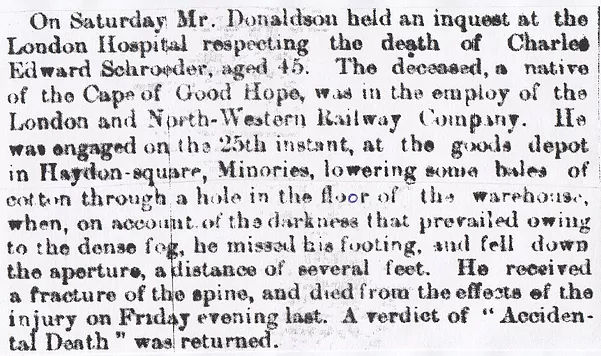
63/ Aldersgate St. Station Suicide, September 1870 (Aldersgate St. Station is now the Barbican Station)
64/ Barclays Bank Fatality, George Yard, July 1870. (George Yard still cobbled, not far from Bank of England)
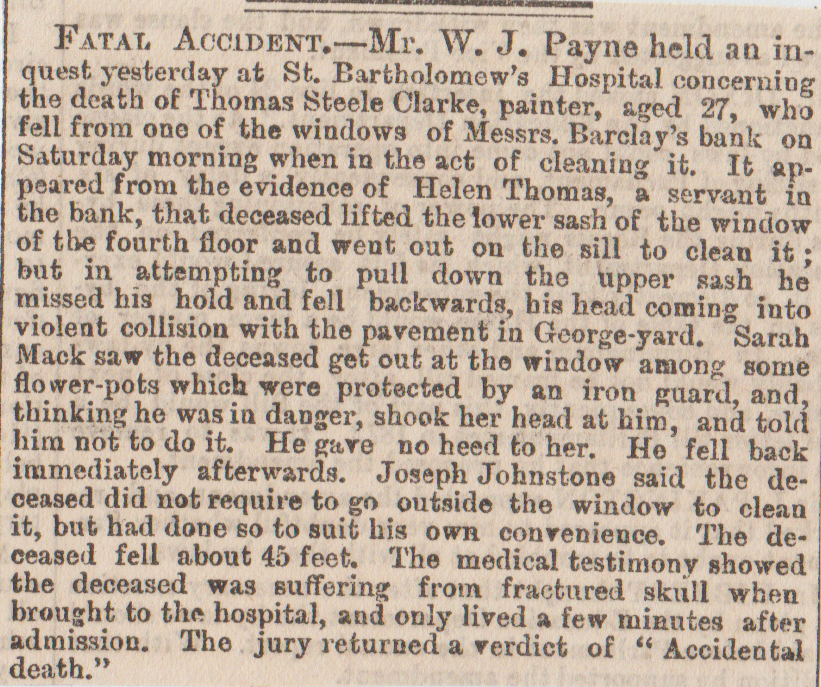
65/ Bishopsgate Fatal Fire (Four Killed) September 1870. (Off Liverpool Street. No.30 next to Arcade)
66/ Fatal Explosion on a Steamer, August 1870. (Fresh Wharf next to London Bridge, where St Magnus Building is now. North Side)
67/ Mystery Death at Whitefriars St, December 1870
68/ Death from Cold, Smithfield Market, December 1870.
On Saturday Mr Richards held an inquest at the Earl of Aberdeen Tavern, Old Ford Road, touching the death of Mr Samuel Gerrish, aged thirty-seven. The deceased was a master butcher carrying on business at 42, Roman Road, Old Ford Road, and at 3 o’clock on Thursday morning he set out in a Hansom cab for the purpose of purchasing a large quantity of meat at Smithfield Market. While in the cab the cold acted upon a diseased heart. The unfortunate man fell back dead in the cab. The driver of the vehicle returned to the dead man’s home. The jury, after hearing the medical evidence, returned a verdict of “Death from excessive cold”.
69/ Body in the Thames, November 1870
Yesterday afternoon Mr Payne held an inquest at Allhallows School-room, Seething Lane, City, touching the death of a man whose name is unknown, and aged about thirty. It appeared from the evidence that on Friday last the deceased was found drowned in the Thames, off the Custom House Quay. He had been dead only about ten hours, and in his right hand was found a short pipe. Thames P.C. Scott, No.83, said he believed the deceased had fallen into the river accidentally during the heavy fog of Thursday night. The man was a labourer employed on the riverside, and he had no doubt during the fog mistaken his way, and, while trying to get on board a barge, slipped and fell into the water. Jury’s verdict – ” Accidentally drowned during the fog”.
70/ Omnibus Fatality, November 1870
71/ Shots Fired in the Bank of England, November 1903. (Attempted Murder of the Secretary)
Monday, February 22nd, 1904 (Detective-Inspector Retires)
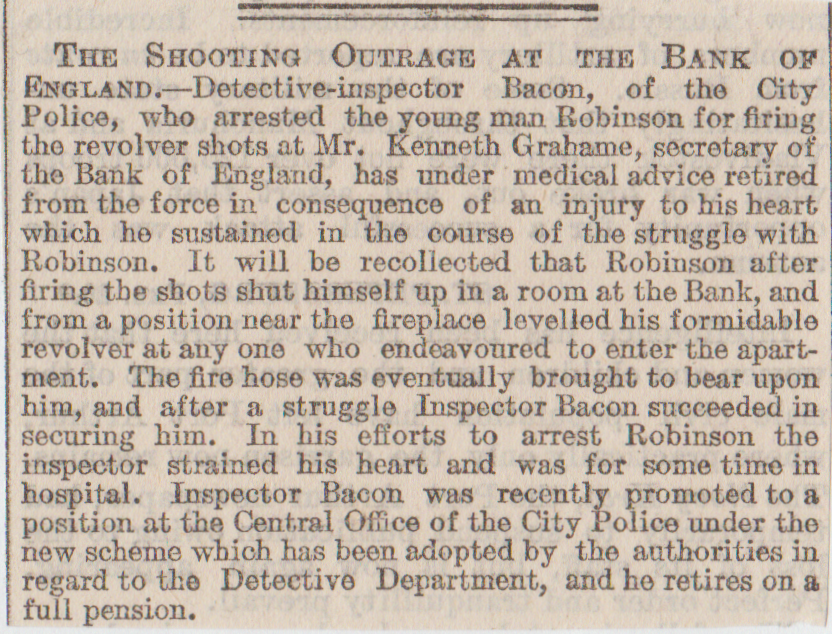
72/ Suicide in Church Passage, City of London. November 1903.
73/ Suicide in Great Winchester Street, October 1903.
74/ U.S. Citizen’s Suicide in London, November 1903. (Suicide note was written at the Hotel Cecil)
75/ Fatal Fire Kills Seven, Duke’s Head Passage, Ivy Lane. March 1904.
76/ “Sensational feat” Causes Death, March 1904.
Dr Waldo held an inquest yesterday at the City Coroner’s Court on the body of Rowland Tomsitt. Tomsitt was employed by Messrs Stapley and Smith, warehouseman, of Fore Street, E.C. and was a member of the firm’s private fire brigade. A month ago he took part in a tournament organized by the London Private Fire Brigades Association and performed the “sensational” feat of the programme. This consisted in leaping from a burning building with a boy into a sheet stretched below. He then sprained one of his feet. The injury being more severe than was anticipated, he was admitted to St Bartholomew’s Hospital, where he died from blood poisoning set up by the accident. A verdict of “Death by misadventure” was returned.
77/ Clerk Attacks Employer with an Axe, January 5th, 1904.
Wednesday, January 6th, 1904.
Thomas Schutz, the clerk lately employed by the Manica Copper Development Company, Cannon Street, who on Monday morning attacked the secretary of the company, Mr W.E.Lane, with a hatchet, gave himself up to City Police at the Cloak Lane Police Station about 8 o’clock last night. Inquiries made at Guy’s Hospital at 11 p.m. last night, showed that Mr Lane was making as favourable progress as could be expected. (In February 1904, the Brixton Gaol Medical Officer considered Schutz to be insane.
78/ Omnibus Fatality on Moorgate Street, City. December 1906.
79/ Danish Naval Lieutenant Found Dead, Temple. March 1907
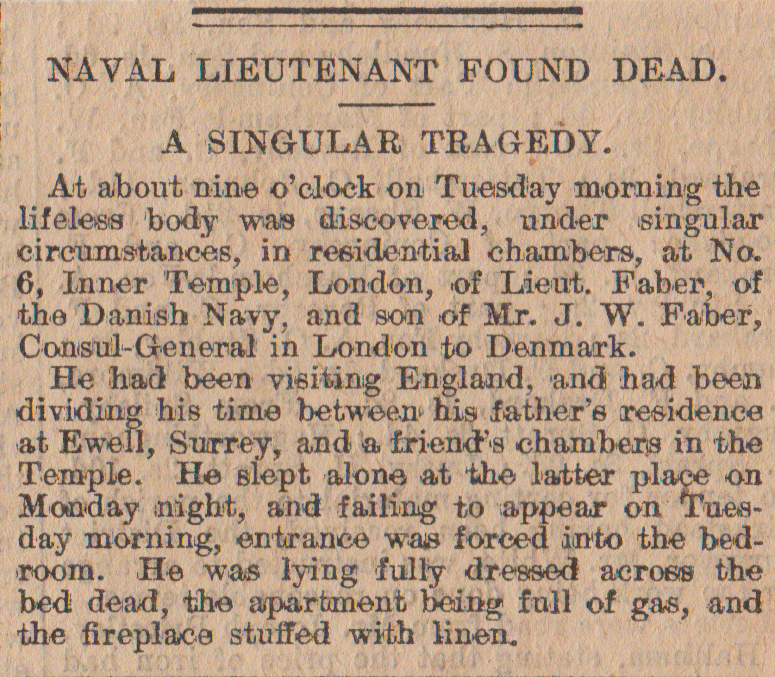
80/ Death at Moorgate Street Station. October 1880
81/ Fatal Accident at Holborn Circus. November 1880
An inquiry was held at St Bartholomew’s Hospital as to the death of William Curtice, aged seventeen, of 22, Little Sutton Street, Clerkenwell. He was employed by Messrs. Carter, Paterson and Co., carriers, of Goswell Street, and on Thursday had been collecting parcels from Messrs Meekings warehouse, Hatton Garden. The van was crossing Holborn Circus at walking pace, when the deceased, who was on top of the vehicle in the front part, missed his footing and fell on the road on his head. Before the driver had become aware of what had happened, the fore wheel of the vehicle passed over the chest of the deceased. He was rushed to the hospital, where he died. The house surgeon, having given evidence, the jury returned a verdict of “Accidental death”.
82/ Omnibus Fatality on Princes Street. October 1880
Another inquest was held at St Bart’s, on the body of Thomas Edscourt, aged fifty-one, who lived at Virgil Street, Circus Road. Deceased, on the afternoon of the 1st of October, was crossing Prince’s Street, Moorgate Street, opposite Grocer’s Hall, when an omnibus driver shouted at him to get out of the way. The deceased got clear of the horses, but the driver who had yelled at him seemed to frighten him, and, stepping backwards, he came against one of the horses, and was knocked down. The fore wheel passed over the deceased, and he was dragged, along several yards. He was taken to a hospital, where he died on the 19th, from injuries received, seventeen of his ribs having been fractured. A verdict of “Accidental death” was returned.

